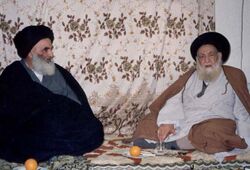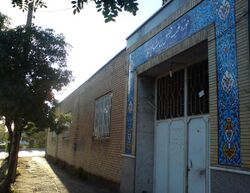Hawza
Topic: Religion
 From HandWiki - Reading time: 7 min
From HandWiki - Reading time: 7 min
A hawza (Arabic: حوزة) or ḥawzah ʿilmīyah (Arabic: حوزة علمیة) is the collective term (plural hawzat)[1] for madrasa (i.e. seminary) where Shi'a Muslim scholars are educated.[2]
The word ḥawzah is found in Arabic as well as the Persian language. In Arabic, the word means "to hold something firmly".[3] Accordingly, ḥawzah ʿilmīyah would mean a place where the firm knowledge (of the Muslim religion) is acquired. In the Persian language, ḥawzah refers to the middle part of a place or an area.[4] Ḥawzah ʿilmīyah in Persian, therefore, means "the place of knowledge". Another meaning of the word is "circle of knowledge".[5]
Several senior Grand Ayatollahs constitute the hawza. The institutions in Najaf, Iraq and Qom, Iran, are the preeminent seminary centers for the education of Shi'a scholars. However, several smaller hawzas exist in other cities around the world, such as at Karbala, Iraq, Isfahan and Mashhad in Iran, Beirut, Lebanon, Lucknow, India , Lahore, Pakistan , Europe and North America.[6]
In countries with sharia courts such as Iran, Pakistan, and Afghanistan, a hawza also functions as a law school for those wanting to practice law in Islamic courts.
Hawza 'Ilmiyya Najaf
Hawza 'Ilmiyya in Najaf, Iraq was established in 430 AH (the 11th century AD) by Shaykh al-Tusi (385 AH/995 CE – 460 AH/1067 CE),[7] and continued as a center of study until the establishment of modern Iraq in 1921.[2][8] At present Ayatollah Sistani heads Hawza 'Ilmiyya Najaf, which includes two other Ayatollahs - Mohammad Ishaq Al-Fayyad and Bashir al-Najafi.[9] After witnessing a peak of some 20,000 students in the 60s, then around 3000 because of the State repression, since 2003, the Najaf hawza has now more than 13,000 students, while the curriculum has been updated to include many modern subjects as well as inter faith and inter sectarian initiatives.[10]
Hawza 'Ilmiyya Qom
Although large Shi'a academies existed in Qom dating back as early as 10th century CE,[9] the hawza of the city became prominent at the time of the Safavids when Shi'a Islam became the official religion of Iran. The famous teachers of that era included Mulla Sadra and Shaykh Bahai.[11][12] The modern Qom hawza (since 1340 AH/1921 CE) was revitalized by Abdul Karim Haeri Yazdi and Grand Ayatollah Borujerdi and is barely a century old.[8][13] As of 1975, major madrasas in Qom which offered religious education included
- Ḥaqqānī (founded 1964),
- the traditional Fayżīya,
- Ḵān,
- Ḥojjatīya, and
- Rażawīya,[14]
traditional madrasas which incorporate some modern elements in the curricula include:
- Dār al-tablīḡ (1965),
- Golpāyegānī (1965), and
- Imam Amīr-al-Moʾmenīn (1975),[14]
Since the revolution of 1979 new madrasas have been founded in Qom, including
- MaʿṢūmīya and
- Maktab-e Zahrā.[15]
Hawza 'Ilmiyya Khwaharan (Women's Hawza)
There are also a number of women's hawza, mostly located in Iran. Already in the early 1800s, the Salehiyya madrasa in Qazvin ran a women's section where several female mujtahids were trained. In Qom, the earliest seminary for women was established by the grand ayatollah Mohammad Kazem Shariatmadari, who in 1973 added a women's section to his hawza Dar al-Tabligh, called Dar al-Zahra.[16] Next, the Haghani school opened a women's wing in 1974/75, called Maktab-e Tawhid.
Outside Qom, women's seminaries included Maktab-e Fatema of Fasa (opened in 1961), Maktab-e Zahra of Shiraz (opened in 1964), Maktab-e Fatimah of Isfahan (opened by Lady Amin in 1965),[17] Zahra-i Athar of Tehran (opened in 1966), and Madrase-ye 'Elmīyya Narges of Mashhad (opened in 1966).[18]
After the 1979 revolution in Iran, the state began to centralize the women's hawza system. The women's seminaries in Qom were centralized into one large school, the Jamiat al-Zahra. In Khorasan with its clerical center of Mashhad, the women's maktabs came under the aegis of the state-run Centre for Management of Women's Seminaries of Khorasan. In the rest of the country, women's seminaries were integrated into the Centre for Management of Women's Seminaries (Markaz-e Modiriat-e Ḥawzahā-ye ʿElmiyya Khwaharān). Since the mid-1990s the latter center has established more than 300 seminaries across Iran (before the revolution less than a dozen existed in the entire country).
Hawza 'Ilmiyya in the West
There are also a number of ḥawzah in the West particularly in the United Kingdom. One of longest established hawza in the UK is Al-Mahdi Institute (AMI). Founded in 1993 by Shaykh Arif Abdulhussain,[19] who received ijāza of ijtihād from Ayatollah Hussain Amini and Ayatollah Professor Sayyid Mostafa Mohaghegh Damad, Al-Mahdi Institute began as an Islamic educational institute (hawza) with the objective of combining traditional seminarian scholarship with modern academic study approaches.[20][21]
The Hawza Programme is at the core of AMI's educational offerings. Modeled on the curriculums of the ḥawzah of Qom and Najaf, it offers training in classical Islamic sciences, employing a critical and academic approach. Courses are primarily taught in English with Arabic language instruction.[22][23] The programme culminates in eligibility for a Master's degree in Islamic Studies from the University of Birmingham.[20][24] Additionally, AMI's 'Transfer Student Scheme' enables students from other Islamic institutions to also join the programme and pursue the MA degree.
Hawza subjects
Hawza students begin their studies by learning fiqh, kalam, hadith, tafsir, philosophy, natural and abstract sciences as well as Arabic and Arabic literature. Once these studies have been completed, they may begin preparation to become a mujtahid by studying advanced old textbooks known as sat'h, and research courses known as kharij.[25]
Subjects studied at the hawza may include the following:[2][9]
- Falsafa (Islamic philosophy)
- Fiqh (jurisprudence)
- 'Ilm al-Hadith (traditions)
- Ilm al-Kalam (theology)
- 'Ilm ar-Rijal (evaluation of biographies)
- 'Irfan (Islamic mysticism)
- Mantiq (Logic)
- Lugha (language studies)
- Tafsir al-Qur'an (interpretation of the Qur'an)
- Tarikh (history)
- 'Ulum al-Qur'an (Qur'an sciences)
- Usul al-Fiqh (principles of jurisprudence)
Advanced subjects
Once the basic studies have been completed, students may begin preparation to become a mujtahid by studying advanced ancient textbooks known as sat'h, and research courses known as kharij.
To be a mujtahid one has to excel in the advanced levels of the Hawza including Muqad'dim'maat, Sotooh, Sotooh 'Ulya, 'Uloom ukhra and Bahath Kharij.
Bahath e Kharij is the last level of hawzah and this level leads to Marja'iya, to become a marja' one has to teach dars e khaarij for considerable amount of time, publish collection of juridical edicts (risala 'amaliyya) and become recognised as one (by established Maraji).[26]
See also
- Marja'
- Madrasa
- Lists of maraji
- List of current maraji
- Qom Seminary
- Society of Seminary Teachers of Qom
- Hawza Najaf
References
- ↑ Qasim Zaman, Muhammad (2010). "11. Epilogue: Competing Conceptions of Religious Education". Schooling Islam: The Culture and Politics of Modern Muslim. Princeton University Press. p. 242. ISBN 978-1400837458. https://books.google.com/books?id=SzCfcQuQKx0C&dq=Dars+al-Kharij+and+hawza.difference+between&pg=PA242. Retrieved 4 September 2023.
- ↑ 2.0 2.1 2.2 "Hawza - Advanced Islamic Studies". Ahlul Bayt Digital Islamic Library Project. http://www.al-islam.org/index.php?t=258&cat=258.
- ↑ "حوزة in English - Translation and Meaning in English Arabic Dictionary of All terms Page 1". https://www.almaany.com/en/dict/ar-en/%D8%AD%D9%88%D8%B2%D8%A9/.
- ↑ "A Comprehensive Persian-English Dictionary - Francis Joseph Steingass". https://archive.org/details/AComprehensivePersian-EnglishDictionary-FrancisJosephSteingass/page/n438/mode/1up.
- ↑ "Shiite Clergy Education: History of the Hawza Ilmiyya". Fondazione Internazionale Oasis. https://www.oasiscenter.eu/en/past-and-present-in-shiite-religious-schools.
- ↑ Frequently Asked Questions (FAQ) on Hawza Studies
- ↑ http://www.al-islam.org/fiqh/chap2.html [1] FIQH and FUQAHA - An Introduction to Fiqh (Islamic Jurisprudence) Containing Forty Four Life Sketches of the Great Past Masters, Published by the WORLD FEDERATION OF KHOJA SHIA ITHNAASHERI MUSLIM COMMUNITIES
- ↑ 8.0 8.1 Sreeram Chaulia. "Shiites and Democracy". Mideast Monitor. http://www.mideastmonitor.org/issues/0705/0705_3.htm.
- ↑ 9.0 9.1 9.2 Thinkin ahead: Shi'ite Islam in Iraq and its seminaries , Christoph Marcinkowsi, Nayang Technological University, Singapore
- ↑ Najaf's Shiite seminaries enter 21st century
- ↑ تاریخ مذهبی قم، ص 131.
- ↑ کتاب النقض، عبدالجلیل بن ابی الفتح، ص 164؛ تاریخ مذهبی قم، علی اصغر فقیهی، قم، چ حکمت، ص 167.
- ↑ M. Rāzī, Āṯār al-ḥojja, volume 1. pp. 1-28, Qom, 1332 Š./1953; quoted in Zaryāb, ʿAbbās (9 December 2011). "EDUCATION v. THE MADRASA IN SHIʿITE PERSIA". https://iranicaonline.org/articles/education-v-the-madrasa-in-shiite-persia.
- ↑ 14.0 14.1 Zaryāb, ʿAbbās (9 December 2011). "EDUCATION v. THE MADRASA IN SHIʿITE PERSIA". https://iranicaonline.org/articles/education-v-the-madrasa-in-shiite-persia.
- ↑ For madrasas in Qom and other centers, see
- M. M. J. Fischer, Iran. From Religious Dispute to Revolution, Cambridge, Mass., 1980., pp. 81-84;
- Ḥ. Modarresī Ṭabāṭabāʾī, "Madāres-e qadīm-e Qom," Waḥīd 8, 1349 Š./1970, pp. 201-06, 409-11; 9, 1350, Š./1971, pp. 126-29, 383-87, 1015-20, 1247-52, 1767-72; 10, 1351 Š./1972, pp. 34-39, 199-206.;
- Chardin, VI, pp. 326-27. Al-Ḏarīʿa. M. Fāżel, "Madāres-e qadīm-e Mašhad," Waḥīd 9, 1349 Š./1970, pp. 1450-53, 1661-68, 1773-78; 10, 1951 Š./1972, pp. 40-44, 207-13, 283-88, 274-79, 675-79.;
- H. Solṭānzāda, Tārīḵ-e madāres-e Īrān az ʿahd-e bāstān tā taʾsīs-e Dār al-fonūn, Tehran, 1364 Š./1985., index;
- A. Baḵšāyešī, Yakṣad sāl mobāreza-ye rūḥānīyat-e motaraqqī, 4 vols., Qom, 1361 Š./1982., IV, pp. 68-88, 154-58. *quoted in Zaryāb, ʿAbbās (9 December 2011). "EDUCATION v. THE MADRASA IN SHIʿITE PERSIA". https://iranicaonline.org/articles/education-v-the-madrasa-in-shiite-persia.
- ↑ Michael M. J. Fischer, Iran: From Religious Dispute to Revolution, Wisconsin: University of Wisconsin Press, 2003, p.196
- ↑ Mirjam Künkler and Roja Fazaeli, "The Life of Two Mujtahidas: Female Religious Authority in 20th Century Iran", in Women, Leadership and Mosques: Changes in Contemporary Islamic Authority, ed. Masooda Bano and Hilary Kalmbach (Brill Publishers, 2012), 127–160. SSRN 1884209
- ↑ Keiko Sakurai, "Women's empowerment and Iranian-style seminaries in Iran and Pakistan," in Keiko Sakurai and Fariba Adelkhah (eds.), The Moral Economy of the Madrasa, Islam and Education Today, (Oxon & New York: Routledge, 2011), p. 32-57
- ↑ "Shaykh Arif" (in en). http://www.shaykharif.com/.
- ↑ 20.0 20.1 Scharbrodt, Oliver (2020). "The Study of Shia Islam in British Academia: Some Preliminary Reflections". Al-Ameed Journal 9 (4): 78. https://www.iasj.net/iasj/download/fd4f416f0a296d85.
- ↑ Van Den Bos, Matthijs (2015). "Western seminary: On transnational Shiite higher education in Britain". Social Compass. 62 62 (2): 241. https://citeseerx.ist.psu.edu/document?repid=rep1&type=pdf&doi=67fd0135485f2f070690dc4bd3588066d3459ce7.
- ↑ Mohamed Mukadam; Alison Scott-Baumann (2010). "The Training and Development of Muslim Faith Leaders: Current Practice and Future Possibilities". Communities and Local Government Publications: 45. https://eprints.soas.ac.uk/26196/1/MFLTR%20report1734121.pdf.
- ↑ "Hawza Programme" (in en-US). https://www.almahdi.edu/hawza/.
- ↑ Shah, Jawad (2019). "Assessing Muslim Higher Education and Training Institutions (METIs) and Islamic Studies Provision in Universities in Britain: An Analysis of Training Provision for Muslim Religious Leadership after 9/11". Religions 10 (11): 623. doi:10.3390/rel10110623.
- ↑ The Concept of Ijtihad in Accordance to Shi'i Islam , Written by Samir Al-Haidari, Monday, 25 December 2006 20:53
- ↑ What is Islam? Beliefs, principles and a way of life, by Abdelmalik Badruddin Eagle (translation of Grand Ayatollah Sayyid Muhammad al-Husayni al-Shirazi's work Ma-huwa 'l-Islam? first published in 1960s)
External links
- Al-Mahdi Institute Hawza Programme, Birmingham, UK
- Towards an Understanding of the Shiite Authoritative Sources
- Hawza Ilmiyya, Qom, Iran
- Research centre of Hawza Ilmiyya, Qom, Iran
- About the Hawza Ilmiyya of Qom, Iran[Usurped!]
- Imam Hossain University (Howza)
- Alqaem Institute
- Hawza - Advanced Islamic Studies
 |
 KSF
KSF


